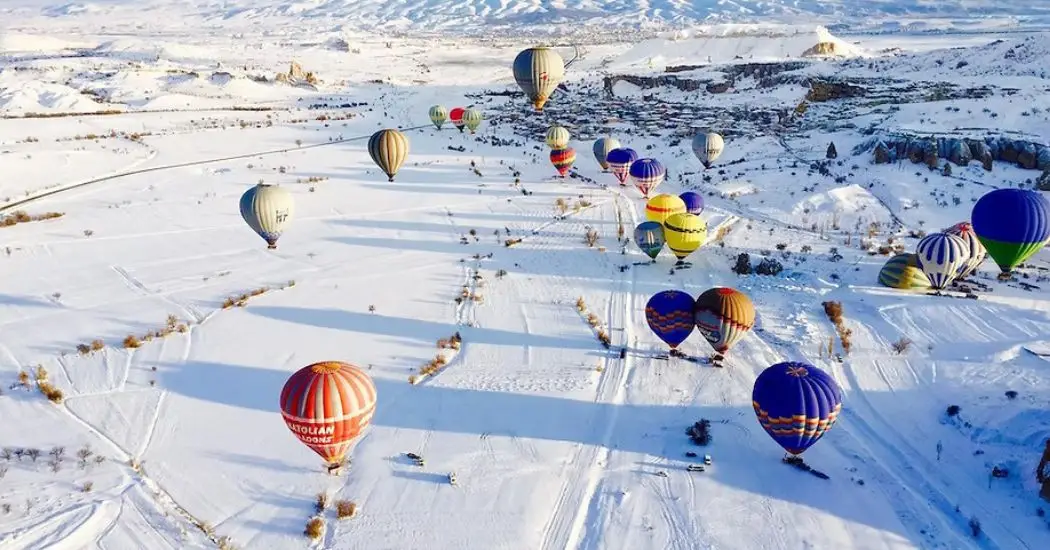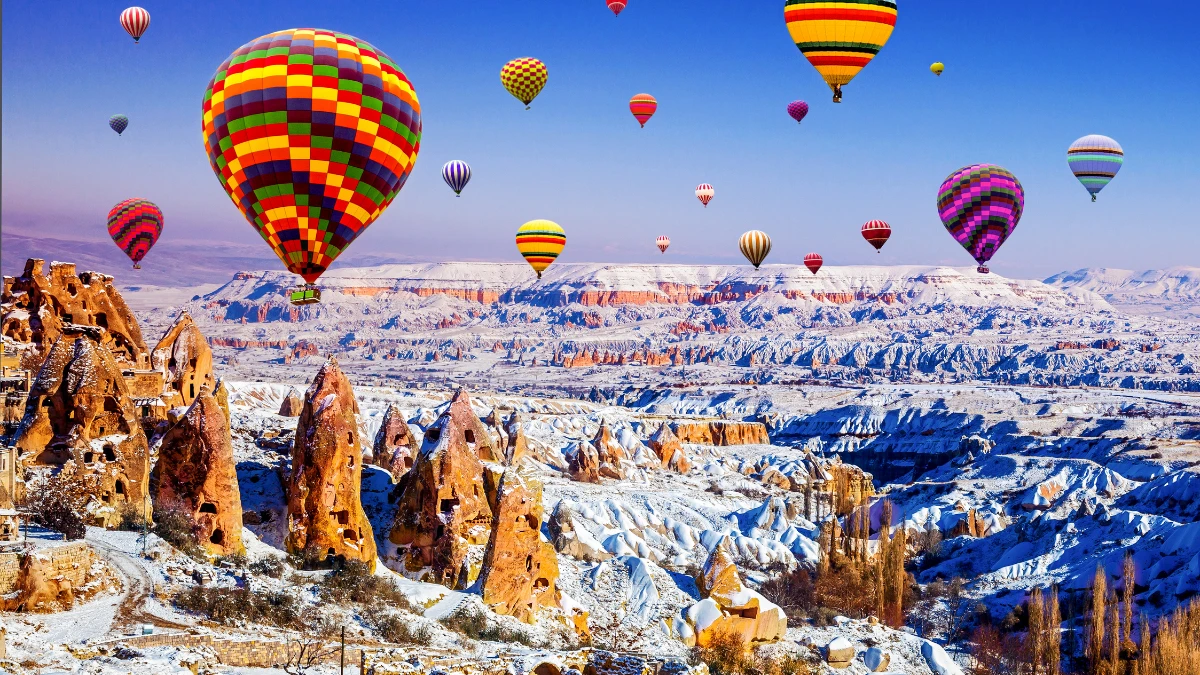
Cappadocia in winter is like a scene from a snow globe – fairy chimneys capped with snow, quiet landscapes, and crisp tranquility.
Visiting in the colder months (December through February) can be a fantastic experience, but it requires little planning and the right expectations.
Here’s a month-by-month rundown of winter, plus tips on what to wear and do:
Winter in December

Image: Alpko.com
Winter starts to set in. Early December can be relatively mild, but it’s quite cold by mid-to-late January. Temperatures average around -2°C to 6°C (28°F to 43°F) during the day and are colder at night.
Snow can arrive, especially later in the month, though it might not stick heavily until after Christmas.
The region gets decorated with a layer of white, making those valley hikes look like Narnia.
What to expect
Fewer crowds than in autumn – a plus! Hotels and cave rooms are generally well-heated (cave hotels stay warm naturally, too).
Some days, you’ll have clear blue skies, which are stunning with the snow contrast. On other days, it could be cloudy or foggy.
Hot air balloons fly in winter whenever weather permits; however, balloon cancellations are more frequent due to wind or precipitation.
If a balloon flight is on your bucket list, plan to have a couple of buffer days in case the first day’s flight is canceled – you can usually reschedule for the next. Around the holidays, you might find special New Year’s Eve events in hotels or restaurants.
Winter in January
January is the coldest month in Cappadocia—think full-on winter wonderland.
Temperatures: During the day, it often stays between -5°C and 0°C (23°F and 32°F), while nights can drop to -10°C (14°F) or even lower. In extreme cold snaps, it’s not unheard of to hit -15 to -20°C, so be sure to bundle up!
Snowfall: January typically sees the most snowfall. It might snow several times, covering the ground and occasionally slowing travel. But the snow transforms the landscape into something magical—frosted rock cones and icicles hanging from cave dwellings.
Tourism: It’s a quieter time, so that you may have major sites almost to yourself.
Daylight: Expect shorter days, with sunset around 5 PM.
Activities: All major sights, such as the Göreme Open-Air Museum, underground cities, and other attractions, remain open—possibly with slightly shorter winter hours. Find out about the Red Tour
- You can still hike if you’re careful. Trekking short snow-covered trails is peaceful—just make sure to wear boots.
- Tour companies operate year-round, and most offer heated vans, so guided tours are still very comfortable.
Prices: One of the perks of visiting in January is that hotel prices can be lower, except around New Year’s week. Just check in advance that your hotel is fully operational—a few smaller ones do close during deep winter, though most stay open.
Winter in February
Still wintery, but towards late February, you start to see the first hints of spring melt.
Temperatures: In early February, they were similar to January, then edged up a little by month’s end (maybe 0–5°C daytime on average). Snow still occurs, but there might be clearer days. Valleys can be a mix of snow and muddy thaw.
What’s open: Everything. Balloons fly when they can (some of the most picturesque balloon shots I’ve seen are in winter with snow on the ground). By mid-February, you gain more daylight; sunset is closer to 5:30-6 pm. It’s still low season, so you get that calm vibe. Book a Balloon ride
What to wear in winter
- Definitely layer up. Indoors (cave hotels, restaurants) are kept warm, so layers let you adjust.
- Essentials include:
- a warm coat (a down jacket or heavy winter coat)
- thermal base layers (leggings/long johns, undershirt) if you plan to be outside a lot
- waterproof shoes/boots with good grip – snow can make rocks slippery, and if it melts, trails get slushy
- A hat (beanie) and gloves are necessary; a scarf or neck gaiter helps, too.
- When it’s windy, the temperature “feels like” it is much colder, so it’s important to have all extremities covered.
- If you’re doing a sunrise balloon ride or early morning hike, wear your warmest clothes because pre-dawn can be frigid (they usually give you hot tea before ballooning, though!).
- Oh, and sunglasses – winter sun + snow glare is real!
- Also, lip balm and moisturizer are needed as the air is dry.
Things to do in winter
Contrary to some beliefs, Cappadocia doesn’t shut down in winter. You can do almost everything:
- Hot Air Balloon: A top highlight, just book a few days in advance to ensure you fly. Seeing snow-covered Cappadocia from above, with maybe fog in valleys and clear sky above, is surreal. Dress very warmly (they give you gloves sometimes, and the burner throws some heat, but it’s still cold up there). Buy the Hot air balloon ticket
- Underground Cities: Perfect winter activity – it’s warmer underground (~10°C/50°F year-round) and you’re shielded from the weather. Places like Derinkuyu or Kaymaklı are fascinating and less claustrophobic in the cold because you welcome the warmth!
- Cave Churches & Museums: Göreme Open-Air Museum is open; a dusting of snow on cave roofs adds charm. Just tread carefully on the steps. The Dark Church there (extra ticket) is indoors, so it’s fine in any weather. Zelve Open-Air Museum – also doable, might close temporarily if paths are too icy, but usually fine by midday after they shovel.
- Hiking: Short hikes are still on the table. Pigeon Valley or Love Valley, if not too snowy (or go with a guide who knows safe paths). Or simply walk around Göreme’s surrounding hills. Some trails might be impassable if heaps of snow, so judge on the ground.
- ATV/Jeep tours: If hiking is out, an ATV ride in the snow could be a blast (though very cold on the face, wear that ski mask!). Jeep safari to remote viewpoints is another way to sightsee without freezing.
- Photography: Winter light and landscapes are a photographer’s dream. Sunrise colors and the contrast of ochre rocks and white snow are stunning. Also, far fewer people will accidentally photobomb your shot.
- Warm up with local experiences: Try a Turkish bath (hamam) – nothing better than steaming and scrubbing in a hamam on a cold day. Cappadocia’s hamams (like the one in Göreme or at your cave hotel’s spa) will warm you to the bone. Also, evenings can be spent enjoying Turkish Night shows (folklore shows are indoors in heated venues). Or simply cozy up in your cave hotel with a glass of local wine by the fireplace (many hotels have lounges with fireplaces or even in-room fireplaces).
- Snow fun: If there’s enough snow, you might see locals sledding on plastic bags or makeshift sleds on small hills – feel free to join the simple fun! Just outside of Cappadocia, the Mount Erciyes ski resort (near Kayseri, ~1 hour away) is an option if you ski or snowboard; some travelers do a day trip for skiing plus Cappadocia touring.
Tip: Driving can be a bit tricky if you rent a car and it snows. Roads are cleared relatively quickly on main routes, but a small rental car might not handle a sudden dump of snow well. Consider hiring a driver if conditions are bad.
Pros and Cons of winter in Cappadocia
Pros: Lower costs, unique scenery, no crowds, cozy cave vibes, and you might experience Cappadocia in a way few do.
Cons: Some days you might be clouded in, some activities might be canceled due to weather, and it’s cold (duh). But if you’re prepared, Cappadocia in winter is enchanting.
Just dress warmly, stay flexible with your plans, and enjoy what is truly a fairy-tale winter landscape. And hey, if you wake up to a snowy morning, grab that camera and head outside – fresh snow on Cappadocia’s rocks is pure magic that will make the cold very worth it.

